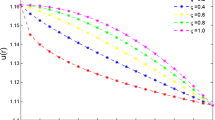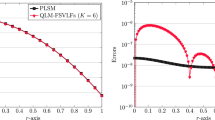Abstract
In this research article, a model of the temperature distribution in the human skull is considered by using the Caputo fractional derivative. When interfering thermometry is lacking, these models are quite useful in estimating the temporal course of temperatures. The given model is numerically solved with the application of the polynomial least-squares scheme. We study various fractional-order cases to simulate the proposed phenomena more clearly compared to the previously proposed integer-order studies. The motivation behind this study is to involve memory effects in the model by using fractional time derivatives.





Similar content being viewed by others
Availability of data and material
The data used in this study are mentioned/available in the manuscript.
Code Availability
There is no code availability statement.
References
Flesch U (1975) The distribution of heat sources in the human head: a theoretical consideration. J Theor Biol 54(2):285–287
Gray BF (1980) The distribution of heat sources in the human head-theoretical considerations. J Theor Biol 82(3):473–476
Srinivasan G, Gopalakrishnan H (2016) A new computational algorithm to nonlinear model of heat conduction in the human head. Int J Chem Technol Res 9(5):536–543
Makinde OD (2010) Non-perturbative solutions of a nonlinear heat conduction model of the human head. Scientific Research and Essays
Anderson N, Arthurs AM (1981) Complementary extremum principles for a nonlinear model of heat conduction in the human head. Bull Math Biol 43(3):341–346
Raja MAZ, Umar M, Sabir Z, Khan JA, Baleanu D (2018) A new stochastic computing paradigm for the dynamics of nonlinear singular heat conduction model of the human head. Eur Phys J Plus 133(9):1–21
Wang KJ (2020) A new fractional nonlinear singular heat conduction model for the human head considering the effect of febrifuge. Eur Phys J Plus 135(11):1–7
Kilbas A, Srivastava HM, Trujillo JJ (2006) Theory and applications of fractional differential equations. Elsevier Science, Amsterdam
Podlubny I (1998) Fractional differential equations: an introduction to fractional derivatives, fractional differential equations, to methods of their solution and some of their applications. Elsevier, Amsterdam
Odibat Z, Baleanu D (2020) Numerical simulation of initial value problems with generalized caputo-type fractional derivatives. Appl Numer Math 156:94–105
Caputo M, Fabrizio M (2015) A new definition of fractional derivative without singular kernel. Progr Fract Differ Appl 1(2):1–13
Kumar P, Erturk VS, Kumar A (2021) A new technique to solve generalized Caputo type fractional differential equations with the example of computer virus model. J Math Ext, p 15
Odibat Z, Erturk VS, Kumar P, Govindaraj V (2021) Dynamics of generalized Caputo type delay fractional differential equations using a modified Predictor-Corrector scheme. Phys Scr 96(12):125213
Kumar P, Erturk VS (2021) Environmental persistence influences infection dynamics for a butterfly pathogen via new generalised Caputo type fractional derivative. Chaos Solitons Fract 144:110672
Kumar P, Erturk VS, Banerjee R, Yavuz M, Govindaraj V (2021) Fractional modeling of plankton-oxygen dynamics under climate change by the application of a recent numerical algorithm. Phys Scr 96(12):124044
Kumar P, Govindaraj V, Erturk VS (2022) A novel mathematical model to describe the transmission dynamics of tooth cavity in the human population. Chaos Solitons Fract 161:112370
Nabi KN, Abboubakar H, Kumar P (2020) Forecasting of COVID-19 pandemic: From integer derivatives to fractional derivatives. Chaos Solitons Fract, p 110283
Nisar KS, Ahmad S, Ullah A, Shah K, Alrabaiah H, Arfan M (2021) Mathematical analysis of SIRD model of COVID-19 with Caputo fractional derivative based on real data. Results Phys 21:103772
OzkOse F, Yavuz M, Şenel MT, Habbireeh R (2022) Fractional order modelling of omicron SARS-CoV-2 variant containing heart attack effect using real data from the United Kingdom. Chaos Solitons Fract 157:111954
Kumar P, Erturk VS, Murillo-Arcila M (2021) A complex fractional mathematical modeling for the love story of Layla and Majnun. Chaos Solitons Fract 150:111091
Erturk VS, Godwe E, Baleanu D, Kumar P, Asad J, Jajarmi A (2021) Novel fractional-order Lagrangian to describe motion of beam on nanowire. Acta Phys Pol A 140(3):265–272
Kumar P, Govindaraj V, Erturk VS, Abdellattif MH (2022) A study on the dynamics of alkali-silica chemical reaction by using Caputo fractional derivative. Pramana 96(3):1–19
Yavuz M, Sene N, Yıldız M (2022) Analysis of the influences of parameters in the fractional second-grade fluid dynamics. Mathematics 10(7):1125
Hammouch Z, Yavuz M, Ozdemir N (2021) Numerical solutions and synchronization of a variable-order fractional chaotic system. Math Model Numer Simul Appl 1(1):11–23
Yavuz M (2022) European option pricing models described by fractional operators with classical and generalized Mittag-Leffler kernels. Numer Methods Partial Differ Equ 38(3):434–456
Avci D, Yavuz M, Ozdemir N (2019) Fundamental solutions to the Cauchy and Dirichlet problems for a heat conduction equation equipped with the Caputo-Fabrizio differentiation. Heat Conduct Methods Appl Res 1:95–107
Erturk VS, Ahmadkhanlu A, Kumar P, Govindaraj V (2022) Some novel mathematical analysis on a corneal shape model by using Caputo fractional derivative. Optik 261:169086
Abdelhakem M, Youssri YH (2021) Two spectral Legendre’s derivative algorithms for Lane-Emden, Bratu equations, and singular perturbed problems. Appl Numer Math 169:243–255
Youssri YH, Abd-Elhameed WM, Doha EH (2015) Ultraspherical wavelets method for solving Lane-Emden type equations. Rom J Phys 60(9–10):1298–1314
Abd-Elhameed WM, Youssri Y, Doha EH (2014) New solutions for singular Lane-Emden equations arising in astrophysics based on shifted ultraspherical operational matrices of derivatives. Comput Methods Differ Equ 2(3):171–185
Doha EH, Abd-Elhameed WM, Youssri YH (2013) Second kind Chebyshev operational matrix algorithm for solving differential equations of Lane-Emden type. New Astron 23:113–117
Sakthivel R, Kavikumar R, Mohammadzadeh A, Kwon OM, Kaviarasan B (2020) Fault estimation for mode-dependent IT2 fuzzy systems with quantized output signals. IEEE Trans Fuzzy Syst 29(2):298–309
Qasem SN, Ahmadian A, Mohammadzadeh A, Rathinasamy S, Pahlevanzadeh B (2021) A type-3 logic fuzzy system: optimized by a correntropy based Kalman filter with adaptive fuzzy kernel size. Inf Sci 572:424–443
Bota C, Caruntu B (2017) Analytic approximate solutions for a class of variable order fractional differential equations using the polynomial least squares method. Fract Calc Appl Anal 20(4):1043–1050
Bota C, Caruntu B (2017) Analytical approximate solutions for quadratic Riccati differential equation of fractional order using the Polynomial Least Squares Method. Chaos Solitons Fract 102:339–345
Caruntu B, Bota C, Lapadat M, Paşca MS (2019) Polynomial least squares method for fractional Lane-Emden equations. Symmetry 11(4):479
Funding
No funding is received for this submission.
Author information
Authors and Affiliations
Contributions
PK was involved in conceptualization, investigation, software, resources, visualization and writing the original draft. VSE was responsible for conceptualization, investigation, software and writing—reviewing and editing. CH took part in conceptualization, supervision, formal analysis and writing—reviewing and editing.
Corresponding author
Ethics declarations
Conflict of interest
The authors declare that they have no competing interests.
Rights and permissions
Springer Nature or its licensor holds exclusive rights to this article under a publishing agreement with the author(s) or other rightsholder(s); author self-archiving of the accepted manuscript version of this article is solely governed by the terms of such publishing agreement and applicable law.
About this article
Cite this article
Kumar, P., Erturk, V.S. & Harley, C. A novel study on a fractional-order heat conduction model for the human head by using the least-squares method. Int. J. Dynam. Control 11, 1040–1049 (2023). https://doi.org/10.1007/s40435-022-01051-y
Received:
Revised:
Accepted:
Published:
Issue Date:
DOI: https://doi.org/10.1007/s40435-022-01051-y




